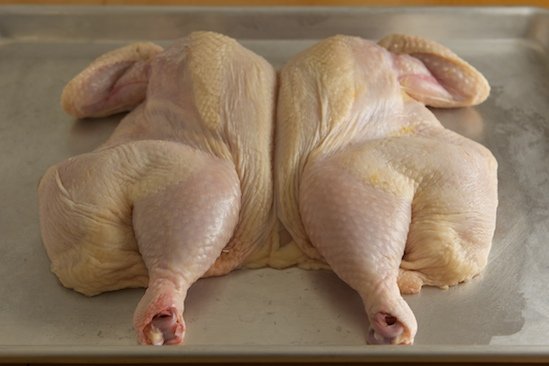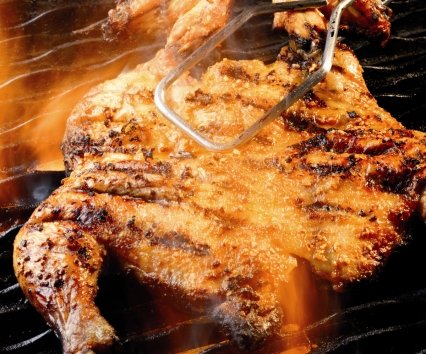"Spatchcock" or "Butterflied" Whole BBQ Chicken layered with Bacon
The term "Spatchcock" comes from 18th Century English and means simply, a fowl that has been split to cook over a fire. There are a dozen different definitions of the term, but that's as close as I've ever needed.
Butterflying a chicken is easy and requires only a good pair of sharp Kitchen Shears or a sharp knife and a safe, steady hand. (Please use scissors so as to not cut yourself)
1) The chicken should be breast down. This means the legs are under the bird, and the wings are on top.
2) Start cutting at one side the neck, just beside the backbone.
3) Cut through the ribs right along the backbone.
4) Continue the cut until it has been made all the way from front to back.
5) Start the second cut just on the other side of the backbone and do the same thing from front to back.
6. You can either just turn the Chicken over and press firmly over the neck area to "crack" the breastbone, or you can remove the breastbone easily by sliding your finger under it until you can gently pry it from the bird. Either method works fine.
7. The chicken should be resting on the insides of the bird, with the skin side up.
8. Now, to prevent over cooking of the breast meat while the legs and thighs cook completely, it's important to "stuff" the breasts with a butter herb mixture or some bacon.
To do this, just GENTLY push your finger between the skin and the breast meat, causing the skin to separate from the meat WITHOUT tearing the skin.
Do this until the entire breast area has the skin loose. Then, gently push some butter/herb mixture under the skin in generous amounts, while gently pushing from the top as well, until the entire breast area is covered, OR push doubled slices of bacon under the skin until the breast area is covered with the bacon between the skin and meat.
9. Now you're ready to season the bird! Many "rubs" are available at the store, or, you can just mix all the seasonings you enjoy on chicken, together at once, and rub it all over the inside and outside of the chicken until it's thoroughly covered. Do this in a manner that won't dislodge the bacon or butter over the breast areas and then put the chicken back on the work surface, skin up.
10. Now, cover the entire bird with slices of bacon. All of it. No gaps, one layer.
11. The bird is ready to cook. While it rests and the seasonings work into the meat some, start the coals for your BBQ.
Indirect cooking on the BBQ is best for this type of cooking. All you have to do is get enough coals going to last an hour. About 20 briquettes is usually enough. If you've planned ahead, you'll also have some wood (cherry or hickory work great) soaked for 24 hours in plain water.
Once all of the coals are uniformly grey, push them to the outside of the grilling area. Place a pan with an inch of wine, juice or broth, under the grill, inside the perimeter of coals.
Place some soaked wood on top of the coals, but not dripping them out. I lay mine out to drain when I start my coals. Just a couple pieces of wood will do. You don't want your meat tasting like firewood.
Now, put the grill on the BBQ and place the bird gently on the center, over the pan.
Put the lid on with all vents wide open.
DO NOT REMOVE THE COVER AGAIN until 60 minutes has passed.
Open after 60 minutes, test the meat by poking the thickest part of the leg with a knife tip, all the way to the bone. If the juices run clear, it's done. if there is still blood showing in the fat, then close the cover and cook longer.
****
That's it! How easy is that? Once you've tried a BBQ chicken this way, you'll be hooked. It makes it look better, and cook better. The breast meat isn't over cooked and the legs and thighs are fully cooked.
The bird is seasoned well and the bacon has given it an additional flavor that is just fantastic.








